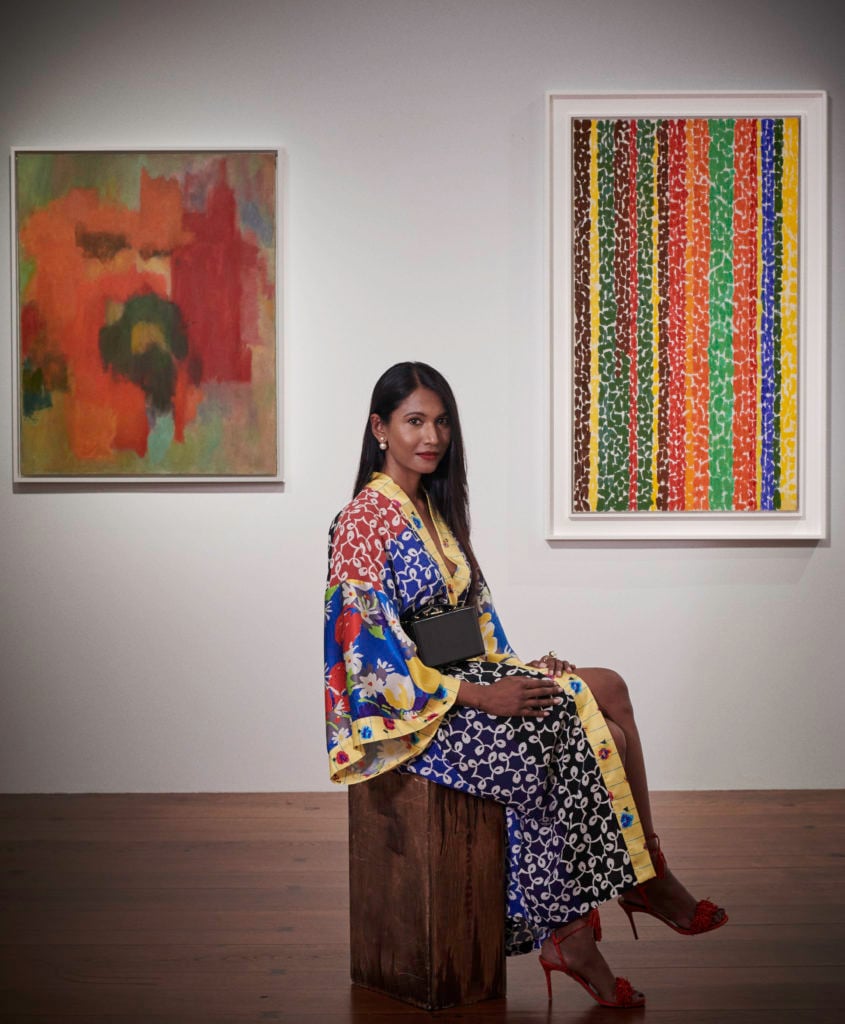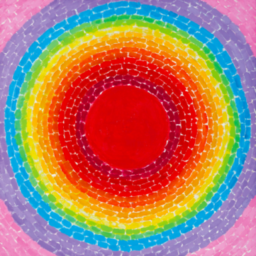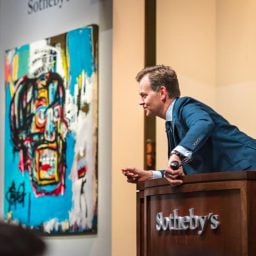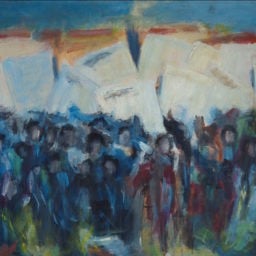“From One Woman to Another,” a five-part series co-produced by artnet News and Mark Cross, features intimate, candid conversations between eminent women at the pinnacle of the art industry and a mentor or protégé of their choosing, paired with original photography by David Lipman.
In the first installment of the series, artnet News’s Noor Brara interviewed art dealer Sukanya Rajaratnam about the late artist Alma Thomas, whose writings and work have guided Rajaratnam in her life and career.
Sukanya Rajaratnam is a force to be reckoned with. A partner at Mnuchin Gallery, where she’s worked for over a decade, Rajaratnam has become one of New York’s most influential art dealers, overseeing the gallery’s high-level institutional sales and the organization of landmark exhibitions for such artists as Cindy Sherman, David Hammons, Sam Gilliam, and Ed Clark.
While the art world is familiar with her fluency in all subjects of contemporary art, few know that Rajaratnam was 18 years old when she first laid eyes on an artwork, or that she left a lucrative, upwardly mobile job in the financial sector to pursue an unpaid internship at Christie’s after she realized that art was her calling. Perhaps even fewer in the industry can fathom that, when she left her family home in her native Sri Lanka to attend college at the University of Cambridge, she also left behind a civil war.
For Rajaratnam, the unsung African American abstract painter Alma Thomas has been a guiding light, with her work containing “great healing power.” Just before the close of a retrospective survey of Alma Thomas’s work that Rajaratnam organized at Mnuchin Gallery’s palatial Upper East Side space, we spoke to the art dealer about how the artist’s legacy has guided her over the years and informed the arc of her career trajectory—even though Thomas herself passed away four decades ago, in 1978.
Tell me about how you first became drawn to a career in the art world. Was there a moment, or an encounter, that inspired you to enter the field?
I have a little bit of an unusual trajectory with art, because I didn’t start working in the industry until I was much older. I grew up in Sri Lanka during the Civil War, so I wasn’t really exposed to any art—I was mostly homeschooled, and even that was sporadic. There were large gaps in my education, including art, which was considered almost a luxury then.
My first encounter with art happened at the age of 18, which is probably much older than for any other dealer you might speak to. It was while I was at Cambridge. The university’s Fitzwilliam Museum had this large sculpture by Henry Moore on the lawn. It was from his Surrealist period, of a woman transmuted into an almost crustacean-like form, broken up. I didn’t even know who Picasso was at the time—that’s how ignorant I was. But this sculpture got my attention, because it was unlike anything I had ever seen. I was studying economics, so art history wasn’t even in my purview, but it did something to me; I was trying to constantly rearrange the pieces because they didn’t quite fit in my linear, mathematical mind. I was trying to understand how this all came to be. So I started going to the museum, and I started going to London to see shows. Coming across that one sculpture started a long love affair with art.
After graduating I came to New York, where, because I was trained as an economist, I did the obvious next step: I became an investment banker. I did that for five years, but I knew that my calling was in art. Then I met someone at Christie’s, and after many, many conversations about the art world and how to enter it—I think I wore them out, quite honestly—they said to me, “You know, if you really love this, you can become an intern and see if you like it, and if you’re any good at it, it might turn into something.”
So you accepted an internship at your advanced stage in your career?
Yes, I took the unpaid internship and, along with it, a massive leap of faith. I left a well-paying job, which I knew I could do well, to do something that didn’t pay at all, and which I really didn’t have any kind of academic or professional preparation for. This was in 2005. The postwar and contemporary art market was just in its ascendance, and I learned about it all through my internship at Christie’s. I started writing the evening sales catalogue from cover to cover—that became my job and my master’s program, essentially. For every highly valuable artwork that came through the door, I would have to research it from scratch and write about it for the catalogue. I loved doing the research, and that became the foundation that I then built upon.
How long did you do that for?
I did that for three years, and then I was ready to be in a different part of the art world. So I interviewed here [at Mnuchin Gallery]. That was 11 years ago. I started as a junior salesperson. I hadn’t sold anything until that point, so it was also a leap of faith on Robert Mnuchin’s part. I remember him saying to me, “You don’t know anything about art. I’m going to take a chance on you.” And 11 years later, here I am.
That’s a great story.
I think it’s encouraging for people who don’t have an affluent or even a typical—I hate to use the word “typical”—background, because if you’re aspiring to be in the art world, or to be an art dealer, you can sometimes feel like you have to come from a collecting family or an affluent family. But you can enter the world of art at a much later point in life and still succeed.
You’ve chosen Alma Thomas as your mentor for this project, which is a really interesting choice given that she passed away many years ago. What is it about her, as an artist and as a person, that you feel so connected to?
I came across Alma Thomas in 2015 when I read an article saying that the White House had recently acquired a painting of hers called Resurrection—which is also the title I chose for our show—and the Obamas had hung it in the old family dining room. It was one of these things that sort of registered, but I didn’t think about it too much. Then, a year later, the Alma Thomas exhibition at the Studio Museum in Harlem opened. Because I remembered the article, I went to see the show. That was the first time I really encountered her work in any depth, and when I started reading about her I realized she was born a century ago, in 1891—she called it the “horse and buggy days.” She lived through this enormous modernization of society.
Coming from a very conservative society in Sri Lanka, where college wasn’t a given for me, I’m very interested in the restrictions that women have faced through the ages. It was probably because of the civil war that I was even allowed to go away for college. I am Tamil, and the idea was that I’d get married and have children; had things not gotten so bad, I think that’s the path I would have taken. So I’ve always been interested in how women have shaped their futures when things were not straightforward, and I love the turn of the century because, regardless of whether you were black or white, it was a turning point for women, when technology was changing and jobs were opening up. And then you head into the First World War, when all the men went away, and more and more opportunities started becoming available for women in the workforce. They started to become the agents of their own futures.
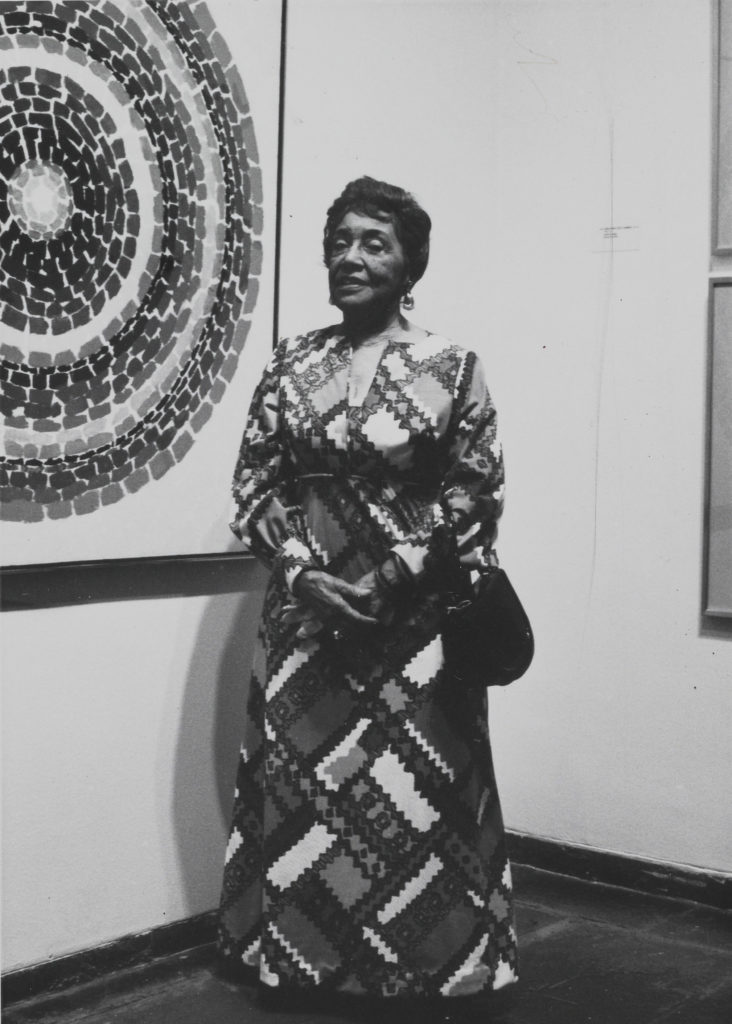
Photograph of Alma Thomas at Whitney Museum of American Art exhibition opening, 1972 / unidentified photographer. Alma Thomas papers, circa 1894-2001. Archives of American Art, Smithsonian Institution.
When you couple this with race, as in Alma’s situation, it creates the really profound set of boundaries that she faced. When I saw the Studio Museum show, all this started hitting me, and I started reading about her and her life. More than anything, I thought her story was incredibly powerful because she was combatting not only racism and sexism, but also ageism and health issues—she didn’t start painting until she was 69, after retiring from being a public high school teacher. Oftentimes she had terrible bouts of arthritis, and she had to tie her paintbrushes to her hands. That’s why her paintings have these short brushstrokes—it’s because she couldn’t physically make a wider range of movement. She was this incredible person who overcame so much, but her attitude is what really struck me. She was always positive.
From my own experience, what has driven me—and I’m not proud of this—is really anger. In Alma’s case, she was completely aware of all the bad situations around her, but she said, “I’m going to deal with this as positively as I can, and from a place of love.” She was very bright. She wanted to become an architect. That was so completely out of the question, so she ended up becoming a teacher in Washington, DC, and channeled all that ambition not into bitterness or resentment but into helping children appreciate art, which she did for 30 years. She was really committed to that. And when she began painting, it was always with the idea that it wasn’t about her life, or her past, or any kind of oppression that she may have faced. Making art, to her, was about beauty and joy and love.
But circling back to why I chose her as my mentor, it’s because I think it’s really important to tell this story, because our actions have so many unexpected consequences, and some of them are really profound and good. The fact that I read this article about her painting hanging in the White House and that led me to see the Studio Museum show, which led me to doing three years of research on Alma, which lead me to putting on this show, which I hope will allow a whole new audience to see and understand the power of this woman—that’s why representation, even on the smallest level, matters. As gallerists, we have a really a significant platform. And it’s incredible how many collectors who have asked who Alma Thomas is. They have no idea. This is where what we do really has implications.
I wrote down a quote of hers, which is, “Through color, I have sought to focus on beauty and happiness rather than on man’s inhumanity to man.” It seems to get to the crux of how you described her outlook on life. Why do you think she was able to get to this place of peace, when anger was so readily available to her?
There are a few stories to draw on here. Alma had hearing difficulties, and her mother told her that it was because, when she was in utero, the mob came to lynch her father. This was in Columbus, Georgia; they lived on a hill, and they were quite prosperous. At the sound of the mob, her mother felt fearful, and the sound of these men coming to get Alma’s father apparently had such an impact on the unborn baby Alma that she blocked out sound. There’s another story about her family: before they crossed the river into Washington, Alma’s mother told her and her sister to shake the sand out of their shoes, because “they were never going back to that place again.” These are stories that resonate with me because that’s how I felt when I left Sri Lanka: “I’m not going back again.”
The way Alma dealt with all of that is very spiritual, transcendental, and positive. She was just a superior person, in many ways. She overcame so much with such generosity. Also, a lot of African American artists at the time—at the height of the civil rights movement—were expected to paint paintings that had clear content, and in fact were criticized for painting abstraction. Her choice to paint abstract was far more profound than painting about racial difficulties. That was an active choice. And the lesson for me, both in her art and from her as a person, is that life is always an act of choice, no matter what happened to you in the past.
What do you hope that people make of her paintings themselves in your survey?
I want to stress that aside from all this, Alma is a fantastic artist who hasn’t been given her due yet. That’s what I’m hoping to correct with this show. At the end of the day, we are an art gallery, so it has to be about the art, primarily. She has long been grouped into the Washington Color School because she was a part of that circle, along with Morris Louis, Kenneth Noland, Sam Gilliam, and Gene Davis. She was well known to them, they respected her greatly, and she had gatherings with them. However, her paintings could not be more different from theirs. For one thing, they’re easel paintings, at the end of the day; for another thing, she was painting with a brush, so none of their pouring or staining comes into play. She was a colorist, but she wasn’t a Color Field painter or a Color School artist—I think that’s an important distinction to make. It’s been a convenient classification, until now.
Secondly, Alma began painting in 1959, coming out of an AbEx school of thought, a year before she retired professionally as an educator. But she came to New York and went to all the gallery shows even as a schoolteacher, so she was incredibly educated, and would have been aware of all the concurrent movements. As a result, yes, she starts out as an AbEx painter, and yes, her stripes and circles come from a vocabulary of seeing Kenneth Noland or Gene Davis, but to me her work is also about the repetition of the brushstrokes and the grid of Minimalism. It was her way of positioning herself not quite within either movement, but doing her own thing. That makes her really singular, and I’m hoping people appreciate that. Why shouldn’t she be thought of along the lines of an Agnes Martin, a Bridget Riley, or a [Yayoi] Kusama? She and Kusama have an affinity that may not be immediately legible, but these are still the artists that are more akin to her, on the whole.
Another person I’ve been thinking about lately is Georgia O’Keeffe, whose life ran parallel to Alma’s. Both of them saw incredible changes in society and technology in their lifetimes. O’Keeffe is truly recognized as being a pioneering American modernist—why isn’t Alma recognized for being a pioneering postwar abstractionist? Alma also made some very deliberate life choices. She never got married; she was very independent. Both were independent, strong women.
Do you have any personal theories on her life choices?
I’ve actually thought that somebody should write a script about Alma’s life—I think the movie-going public would be fascinated by her story. But her personal life is still a bit of a mystery. We found a diary entry that she wrote: “Once upon a time, it was said, ‘Don’t die having a ‘Ms.’ on your tombstone.’ I feel very proud of having maintained my ‘Ms.’ I say that Ms. stands for all the jackasses I missed in my life.” It’s hilarious. And there’s more where that came from. I think she could have a massive cultural moment.
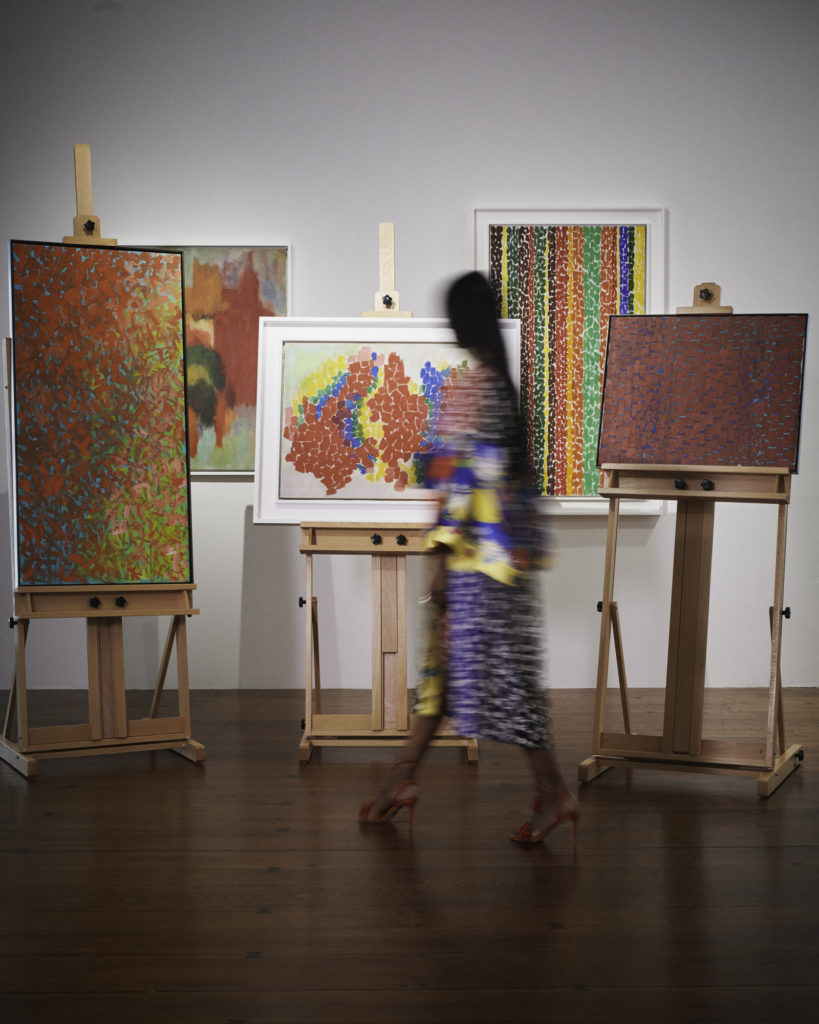
Sukanya Rajaratnam surrounded by Alma Thomas’s works at Mnuchin Gallery. Photo by David Lipman.
Bringing all this into the present, from your own experience and what you’ve gathered from Alma, what advice do you have for young women about what they can do to succeed in this industry?
I think it’s daunting when you first enter—“lonely” is the word, really. I’m very sensitive to these young women, because my generation had very little to model on. We kind of had to make our way, and some of us are actively trying to make it a friendlier place for young women, and make sure we are available for them to approach us. I feel very strongly about that. It’s been quite male-dominated, as we all know.
I would reach out to all the more established women and say, “Make yourself available,” because everyone needs someone at some point. To the young women, I would say we’re all moving in a direction where there’s no “right” path. Especially in an industry like this—you’ve got to forge your own, so don’t be afraid of taking some chances. You’re going to fail sometimes, but having courage is important. That’s another thing I learned from Alma. She just didn’t care what people thought—which is wonderful. She had a deep conviction for what she was doing as a teacher and as an artist and she never questioned herself. So that’s what I would say to women: have conviction.
Do you have any thoughts on the elusive concept of work–life balance, which women these days are constantly being asked about?
That’s a really hard question—it’s something I struggle with every day. I have a nine-year-old son whose name is Aditya, which means the sun in Sanskrit; he was born on the summer solstice. I don’t totally know how to answer this… I hope what I’m doing is the right thing, but I don’t know. Everyone has to make that choice. As an art dealer, you’re expected to do so much, especially with travel, and there’s no way around it, really. I wish there were. But, again, women judge themselves much more harshly, in this regard. Men have demanding jobs, but they don’t question, “Is my child suffering as a result of this?” Women always do. And that’s going to take a long time to change. I hope that I’m modeling behavior that encourages my son to see women as equals. That’s what I hope to accomplish.
What’s one thing that you would like people to know about engaging with art, generally?
I’d like them to do it more often. Going back to Alma, it’s not just her artistic brilliance that has had this impact on me, it’s her personality. Art can open you up to realizations about yourself, which is ultimately our purpose on this planet. For me, I chose Alma as a mentor because she’s shed so much light on how I’ve approached things in the past, and how I hope to change things. She’s really a beacon for me.
Photographer: David Lipman
Art Director: Yulu Serao
Stylist: Melena Lipman
Hair: Yoichi Tomizawa
Makeup: Yinna Wang
